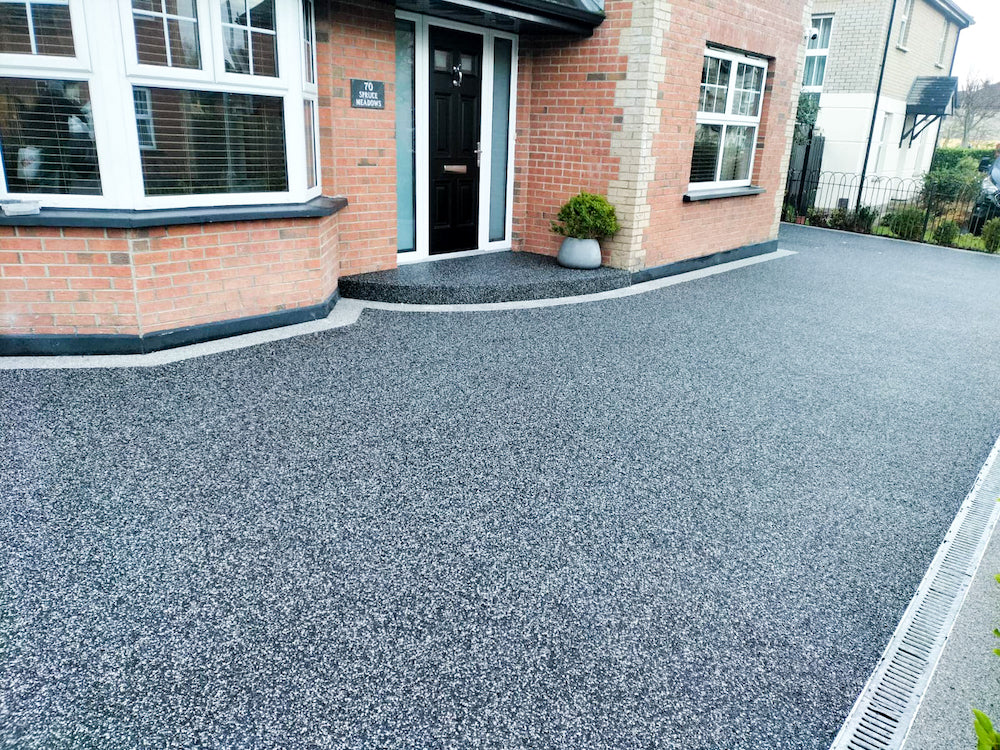Introduction
A resin-bound driveway is a durable and attractive addition to any home, offering a smooth, long-lasting surface that enhances curb appeal. However, like any outdoor surface, resin driveways can experience wear and tear over time. Cracks can develop due to various factors, such as weather conditions, heavy traffic, or ground movement. The good news is that repairing resin-bound driveway cracks is a straightforward process, and with proper maintenance, you can prevent future damage.
In this blog post, we’ll cover how to repair cracks in your resin-bound driveway, explore the common causes of these cracks, and provide practical tips on how to prevent future damage. By understanding the right techniques and maintenance practices, you can ensure your driveway remains in top condition for years to come.
Understanding Resin Bound Driveway Cracks: Causes and Prevention
Before starting the repair process, it’s essential to understand why cracks appear in resin bound driveways. Identifying the underlying causes will help prevent similar issues in the future.
Weather Conditions
Extreme weather conditions, such as freezing temperatures in the winter and hot summers, can cause resin-bound driveways to expand and contract. These temperature fluctuations can lead to cracks, especially if the driveway wasn’t installed with proper drainage or flexibility to account for these changes.
Ground Movement
Ground movement or soil settling beneath your driveway can lead to cracks. This is especially common in areas prone to shifting soils or in regions where the ground frequently freezes and thaws. Without proper preparation during installation, these natural movements can put stress on the driveway surface, leading to cracking.
Heavy Traffic
While resin-bound driveways are designed to handle light to moderate traffic, heavy loads such as large vehicles or frequent use by commercial vehicles can cause the surface to weaken over time. Repeated exposure to heavy loads can result in cracks and surface deterioration.
Poor Installation
In some cases, cracks can be caused by improper installation. If the resin-bound surface wasn’t laid on a stable base or if the wrong type of resin was used for the climate, the driveway may not have the flexibility it needs to withstand pressure and temperature changes. A lack of proper sealing or edging can also contribute to cracking over time.
How to Repair Cracks in a Resin Bound Driveway
Repairing cracks in a resin bound driveway is a relatively simple process, but it’s essential to follow the correct steps to ensure a long-lasting fix. Here’s a step-by-step guide to help you repair driveway cracks effectively:
Assess the Damage
Before starting the repair, carefully inspect the cracks to determine their size and depth. Small, hairline cracks are easier to fix, while larger, deeper cracks may require more extensive repairs. If you notice widespread cracking, it might be a sign of a deeper issue with the driveway’s base or drainage system.
Clean the Affected Area
To achieve a strong bond between the repair material and the existing driveway, it’s crucial to clean the cracked area thoroughly. Use a stiff brush or a pressure washer to remove dirt, debris, and loose particles from the crack. Allow the area to dry completely before proceeding with the repair.
Prepare the Repair Resin
Once the crack is clean and dry, prepare the resin repair material. Many resin repair kits come pre-mixed, but if you’re mixing the resin and aggregate yourself, follow the manufacturer’s instructions carefully. Make sure the aggregate matches the existing surface for a seamless repair. You can also add a UV-stable resin to prevent discoloration over time.
Fill the Crack
Apply the prepared resin mixture to the crack using a trowel or putty knife. Press the material into the crack, ensuring it fills the entire space evenly. Smooth the surface with the trowel so that it matches the rest of the driveway. If you’re repairing a larger crack, you may need to apply the resin in layers, allowing each layer to cure before adding the next.
Let the Repair Cure
After filling the crack, the resin needs time to cure. The curing time will depend on the product used and the weather conditions, but typically, it takes 24 to 48 hours for the resin to harden fully. To ensure a durable finish, avoid driving or walking on the repaired area until the resin has cured completely.
Seal the Driveway
Once the crack repair is complete and the surface has cured, consider sealing the driveway to protect it from future damage. A high-quality resin sealant can help prevent water penetration, UV damage, and other environmental factors that contribute to cracking. Sealing also gives your driveway a fresh, polished look and extends its lifespan.
Preventing Future Damage to Your Resin Bound Driveway
Now that you’ve repaired the cracks, it’s time to focus on preventing future damage. With proper maintenance and a few preventative measures, you can keep your resin-bound driveway looking its best for years to come.
Regular Cleaning and Maintenance
Keeping your driveway clean is one of the simplest ways to prevent damage. Regularly sweep away debris, dirt, and leaves to prevent them from accumulating and trapping moisture. You can also use a pressure washer to remove stubborn dirt and grime. However, be cautious not to use high pressure directly on the resin surface, as this could damage the finish.
Reseal the Driveway
Sealing your resin-bound driveway every two to three years helps protect the surface from wear and tear. A sealant acts as a protective layer that prevents water from seeping into the resin and causing cracks. It also shields the driveway from UV rays, which can cause the resin to fade or weaken over time.
Address Drainage Issues
One of the leading causes of driveway cracks is poor drainage. Ensure that your driveway has proper drainage systems in place to prevent water from pooling on the surface. If you notice any areas where water tends to collect, take steps to improve drainage by adding channels or adjusting the slope of the driveway.
Avoid Heavy Vehicles
While resin bound driveways are durable, they are not designed to withstand extremely heavy loads regularly. Avoid parking large trucks, trailers, or other heavy vehicles on your driveway, as this can put unnecessary strain on the surface and lead to cracking.
Repair Cracks Early
Don’t wait for small cracks to turn into big problems. The earlier you address minor damage, the easier and cheaper the repair process will be. Regularly inspect your driveway for any signs of wear and tear, and take action as soon as you notice cracks or other issues.
Monitor Temperature Changes
If you live in an area with extreme temperature changes, it’s essential to monitor the condition of your driveway during these times. Freezing and thawing cycles can cause expansion and contraction in the resin surface, leading to cracks. If necessary, apply de-icing products to prevent ice from forming, but avoid using harsh chemicals that could damage the resin.
Conclusion: Keep Your Resin Bound Driveway in Top Condition
Cracks in a resin bound driveway can be a nuisance, but they are usually easy to repair if addressed early. By following the steps outlined above, you can fix cracks and prevent them from spreading, restoring your driveway’s appearance and functionality. Moreover, with regular maintenance and preventative measures, you can reduce the risk of future damage and extend the lifespan of your driveway.
Whether you’re dealing with minor cracks or looking for ways to maintain your driveway long-term, investing in the proper care of your resin-bound surface will pay off in the form of a beautiful, durable, and low-maintenance driveway.
For further information, click here visit our website or call Resin Driveways Wigan on 01942-559729.
Click here to complete our contact form and see how we can help you with your resin bound surfacing needs.



